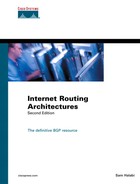How BGP Works
BGP is a path vector protocol used to carry routing information between autonomous systems. The term path vector comes from the fact that BGP routing information carries a sequence of AS numbers that identifies the path of ASs that a network prefix has traversed. The path information associated with the prefix is used to enable loop prevention.
BGP uses TCP as its transport protocol (port 179). This ensures that all the transport reliability (such as retransmission) is taken care of by TCP and does not need to be implemented in BGP, thereby simplifying the complexity associated with designing reliability into the protocol itself.
Routers that run a BGP routing process are often referred to as BGP speakers. Two BGP speakers that form a TCP connection between one another for the purpose of exchanging routing information are referred to as neighbors or peers. Figure 5-2 illustrates this relationship. Peer routers exchange open messages to determine the connection parameters. These messages are used to communicate values such as the BGP speaker's version number.
Figure 5-2. BGP Routers Become Neighbors
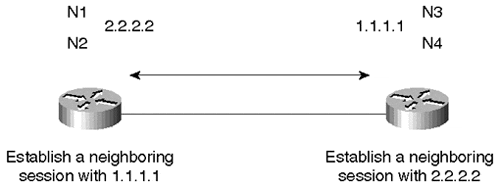
BGP also provides a mechanism to gracefully close a connection with a peer. In other words, in the event of a disagreement between the peers, be it resultant of configuration, incompatibility, operator intervention, or other circumstances, a NOTIFICATION error message is sent, and the peer connection does not get established or is torn down if it's already established. The benefit of this mechanism is that both peers understand that the connection could not be established or maintained and do not waste resources that would otherwise be required to maintain or blindly reattempt to establish the connection. The graceful close mechanism simply ensures that all outstanding messages, primarily NOTIFICATION error messages, are delivered before the TCP session is closed.
Initially, when a BGP session is established between a set of BGP speakers, all candidate BGP routes are exchanged, as illustrated in Figure 5-3. After the session has been established and the initial route exchange has occurred, only incremental updates are sent as network information changes. The incremental update approach has shown an enormous improvement in CPU overhead and bandwidth allocation compared with complete periodic updates used by previous protocols, such as EGP.
Figure 5-3. Exchanging All Routing Updates

Routes are advertised between a pair of BGP routers in UPDATE messages. The UPDATE message contains, among other things, a list of <length, prefix> tuples that indicate the list of destinations that can be reached via a BGP speaker. The UPDATE message also contains the path attributes, which include such information as the degree of preference for a particular route and the list of ASs that the route has traversed.
In the event that a route becomes unreachable, a BGP speaker informs its neighbors by withdrawing the invalid route. As illustrated in Figure 5-4, withdrawn routes are part of the UPDATE message. These routes are no longer available for use. If information associated with a route has changed, or a new path for the same prefix has been selected, a withdrawal is not required; it is enough to just advertise a replacement route.
Figure 5-4. N1 Goes Down; Partial Update Sent

Figure 5-5 illustrates a steady state situation: If no routing changes occur, the routers exchange only KEEPALIVE packets.
Figure 5-5. Steady State; N1 Is Still Down

KEEPALIVE messages are sent periodically between BGP neighbors to ensure that the connection is kept alive. KEEPALIVE packets (19 bytes each) should not cause any strain on the router CPU or link bandwidth, because they consume a minimal amount of bandwidth (one instantaneous 152-bit packet every 60 seconds, or about 2.5 bps per peer for a periodic rate of 60 seconds).
BGP keeps a table version number to keep track of the current instance of the BGP routing table. If the table changes, BGP increments the table version number. A table version that increments rapidly is usually an indication of network instability (although this is quite common in large Internet service provider networks). Because of this, instability introduced by Internet-connected networks anywhere in the world will result in the table version number incrementing on every BGP speaker that has a full view of the Internet routing tables. Route flap dampening and other provisions (discussed in detail in Chapter 10, "Designing Stable Internets") have been designed to scope the effects of this instability.
BGP Message Header Format
The BGP message header format is a 16-byte Marker field, followed by a 2-byte Length field and a 1-byte Type field. Figure 5-6 illustrates the basic format of the BGP message header.
Figure 5-6. BGP Message Header Format
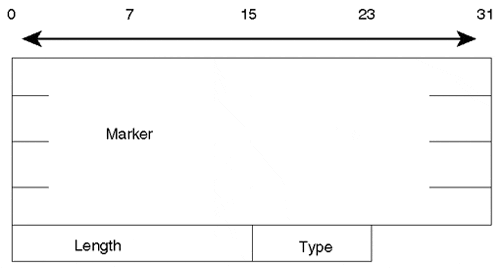
Depending on the message type, there might or might not be a data portion following the header. KEEPALIVE messages, for example, consist of the message header only, with no following data.
The 16-byte Marker field is used to either authenticate incoming BGP messages or detect loss of synchronization between two BGP peers. The Marker field can have one of two formats:
-
If the type of the message is OPEN, or if the OPEN message has no authentication information, the Marker field must be all 1s.
-
Otherwise, the Marker field will be computed based on part of the authentication mechanism used. Later in this chapter, I will discuss the TCP MD5 Signature Option's use of this marker.
The 2-byte Length field is used to indicate the total BGP message length, including the header. The smallest BGP message is no less than 19 bytes (16+2+1) and no greater than 4,096 bytes.
The 1-byte Type field indicates the message type, with the following possibilities:
-
OPEN
-
UPDATE
-
NOTIFICATION
-
KEEPALIVE
The following sections examine the purpose and format of each of the four message types in more detail.
BGP Neighbor Negotiation
One of the basic steps of the BGP protocol is establishing sessions between BGP peers. Without successful completion of this step, the exchange of updates will not occur. Neighbor negotiation is based on the successful completion of a TCP transport connection, the successful processing of the OPEN message, and periodic detection of the UPDATE or KEEPALIVE messages.
OPEN Message Format
Figure 5-7 illustrates the format of the OPEN message.
Figure 5-7. Open Message Format
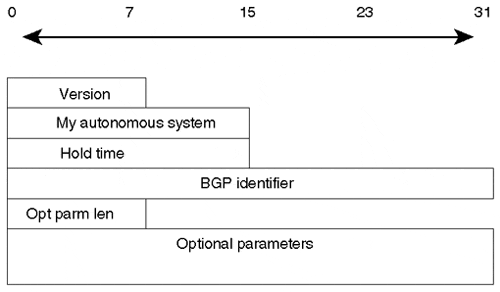
The following descriptions summarize each of the OPEN message fields:
-
Version— A 1-byte unsigned integer that indicates the version of the BGP message, such as BGP-3 or BGP-4. During the neighbor negotiation, BGP peers agree on a BGP version number. BGP peers try to negotiate the highest common version that they both support. They reset the BGP session and renegotiate until a common supported version is determined by the peers. Cisco Systems provides the option of predefining the version negotiated to cut down on the negotiation process. The version is usually set statically when the versions of the BGP peers are already known, although most implementations begin and default to BGP-4.
-
My Autonomous System— A 2-byte field that indicates the AS number of the BGP speaker.
-
Hold Timer— The Hold Timer is a 2-byte unsigned integer that indicates the maximum amount of time in seconds that may elapse between the receipt of successive KEEPALIVE or UPDATE messages. The Hold Timer is a counter that increments from 0 to the hold time value. Receipt of a KEEPALIVE or UPDATE message causes the Hold Timer to reset to 0. If the hold time for a particular neighbor were exceeded, the neighbor would be considered dead.
The BGP router negotiates with its neighbor to select the hold time at whichever value is lower—its own Hold Timer or its neighbor's. The Hold Timer could be 0, in which case the Hold Timer and the KEEPALIVE timers are never reset. In other words, these timers never expire, and the connection is considered to be always up. If it isn't set to 0, the minimum Hold Timer is 3 seconds.
Note that the negotiation done for the Version Number (by actually resetting the session until both nodes agree on a common Version) and the one for the Hold Timer (use the minimum value of the two BGP speakers) are very different. In both cases, only the OPEN message is sent by each router. However, if the values don't match (in the case of Hold Timer), the session is not reset.
-
BGP Identifier— A 4-byte unsigned integer that indicates the value of the sender's BGP ID. In Cisco's implementation, this is usually equal to the Router ID (RID), which is calculated as the highest IP address on the router or the highest loopback address at BGP session startup. A loopback address is a representation of the IP address of a virtual software interface that is considered to be up at all times, irrespective of the state of any physical interface.
-
Optional Parameter Length (Opt Parm Len) — This is a 1-byte unsigned integer that indicates the total length in bytes of the Optional Parameters field. A length value of 0 indicates that no Optional Parameters are present.
-
Optional Parameters— This is a variable-length field that indicates a list of optional parameters used in BGP neighbor session negotiation. This field is represented by the triplet <Parameter Type, Parameter Length, Parameter Value> with lengths of 1 byte, 1 byte, and variable length, respectively. An example of optional parameters is the authentication information parameter (type 1), which is used to authenticate the session with a BGP peer.
Finite State Machine Perspective
BGP neighbor negotiation proceeds through different stages before the connection is fully established. Figure 5-8 illustrates a simplified finite state machine (FSM) that highlights the major events in the process with an indication of messages (OPEN, KEEPALIVE, NOTIFICATION) sent to the peer in the transition from one state to the other.
Figure 5-8. BGP Neighbor Negotiation Finite State Machine
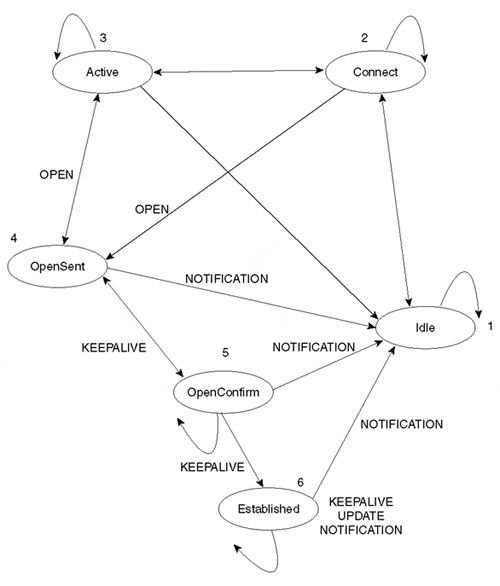
The following list summarizes the key states in the FSM example illustrated in Figure 5-8:
-
Idle— This is the first stage of the connection. BGP is waiting for a Start event, which is initiated by an operator or the BGP system. An administrator establishing a BGP session through router configuration or resetting an already existing session usually causes a Start event. After the Start event, BGP initializes its resources, resets a ConnectRetry timer, initiates a TCP transport connection, and starts listening for a connection that may be initiated by a remote peer. BGP then transitions to a Connect state. In case of errors, BGP falls back to the Idle state.
-
Connect— BGP is waiting for the transport protocol connection to be completed. If the TCP transport connection is successful, the state transitions to OpenSent (this is where the OPEN message is sent). If the transport connection is unsuccessful, the state transitions to Active. If the ConnectRetry timer expires, the state remains in the Connect stage, the timer is reset, and a transport connection is initiated. In case of any other event (initiated by system or operator), the state goes back to Idle.
-
Active— BGP tries to acquire a peer by initiating a transport protocol connection. If the transport connection is established, it transitions to OpenSent (an OPEN message is sent). If the ConnectRetry timer expires, BGP restarts the ConnectRetry timer and falls back to the Connect state. In addition, BGP continues to listen for a connection that might be initiated from another peer. The state might go back to Idle in case of other events, such as a Stop event initiated by the system or the operator.
In general, a neighbor state that is oscillating between Connect and Active indicates that something is wrong with the TCP transport connection. It could be because of many TCP retransmissions or the inability of a neighbor to reach the IP address of its peer.
-
OpenSent— BGP is waiting for an OPEN message from its peer. The OPEN message is checked for correctness. In case of errors, such as a bad version number or an unacceptable AS, the system sends an error NOTIFICATION message and goes back to Idle. If there are no errors, BGP starts sending KEEPALIVE messages and resets the KEEPALIVE timer. At this stage, the hold time is negotiated, and the smaller value is taken. In case the negotiated hold time is 0, the Hold Timer and the KEEPALIVE timer are not restarted.
At the OpenSent state, the BGP recognizes, by comparing its AS number to the AS number of its peer, whether the peer belongs to the same AS (Internal BGP) or to a different AS (External BGP).
When a TCP transport disconnect is detected, the state falls back to the Active state. For any other errors, such as an expiration of the Hold Timer, the BGP sends a NOTIFICATION message with the corresponding error code and falls back to the Idle state. Also, in response to a stop event initiated by the system or the operator, the state falls back to the Idle state.
-
OpenConfirm— BGP waits for a KEEPALIVE message. If a KEEPALIVE is received, the state goes to Established, and the neighbor negotiation is complete. If the system receives a KEEPALIVE message, it restarts the Hold Timer (assuming that the negotiated Hold Time is not 0). If a NOTIFICATION message is received, the state falls back to the Idle state. The system sends periodic KEEPALIVE messages at the rate set by the KEEPALIVE timer. In case of any transport disconnect notification or in response to any stop event (initiated by the system or the operator), the state falls back to Idle. In response to any other event, the system sends a NOTIFICATION message with an FSM (Finite State Machine) error code and returns to the Idle state.
-
Established— This is the final stage in the neighbor negotiation. At this stage, BGP starts exchanging UPDATE packets with its peers. Assuming that it is nonzero, the Hold Timer restarts at the receipt of an UPDATE or KEEPALIVE message. If the system receives any NOTIFICATION message (if an error has occurred), the state falls back to Idle.
The UPDATE messages are checked for errors, such as missing attributes, duplicate attributes, and so on. If errors are found, a NOTIFICATION message is sent to the peer, and the state falls back to Idle. If the Hold Timer expires, or a disconnect notification is received from the transport protocol, or a Stop event is received, or in response to any other event, the system falls back to the Idle state.
NOTIFICATION Message
From the preceding examination of the Finite State Machine, it should be apparent that many opportunities exist among the various states for errors to be detected. A NOTIFICATION message is always sent whenever an error is detected. After that, the peer connection is closed. Network administrators need to evaluate these NOTIFICATION messages to determine the specific nature of errors that emerge in the routing protocol. Figure 5-9 illustrates the general message format.
Figure 5-9. NOTIFICATION Message Format

The NOTIFICATION message is composed of the Error code (1 byte), the Error subcode (1 byte), and the Data field (variable).
The Error code indicates the type of the notification, and the Error subcode provides more specific information about the nature of the error. The Data field contains data relevant to the error, such as a bad header, an illegal AS number, and so on. Table 5-1 lists possible errors and their subcodes.
| Error Code | Error Subcode |
|---|---|
| 1—Message header error | 1—Connection Not Synchronized
2—Bad Message Length 3—Bad Message Type |
| 2—OPEN message error | 1—Unsupported Version Number
2—Bad Peer AS 3—Bad BGP Identifier 4—Unsupported Optional Parameter 5—Authentication Failure 6—Unacceptable Hold Timer 7—Unsupported Capability |
| 3—UPDATE message error | 1—Malformed Attribute List
2—Unrecognized Well-Known Attribute 3—Missing Well-Known Attribute 4—Attribute Flags Error 5—Attribute Length Error 6—Invalid Origin Attribute 7—AS Routing Loop 8—Invalid NEXT_HOP Attribute 9—Optional Attribute Error 10—Invalid Network Field 11—Malformed AS_PATH |
| 4—Hold Timer expired | N/A |
| 5—Finite State Machine error (for errors detected by the FSM) | N/A |
| 6—Cease (for fatal errors besides the ones already listed) | N/A |
KEEPALIVE Message
KEEPALIVE messages are periodic messages exchanged between peers to determine whether peers are reachable. As discussed earlier, the hold time is the maximum amount of time that may elapse between the receipt of successive KEEPALIVE or UPDATE messages. The KEEPALIVE messages are sent at a rate that ensures that the hold time will not expire (the session is considered alive). A recommended KEEPALIVE rate is one-third of the Hold Timer value. If the Hold Timer value is 0, periodic KEEPALIVE messages are not sent. As previously mentioned, the KEEPALIVE message is a 19-byte BGP message header with no data following it, or it can be suppressed during an interval if an UPDATE message is sent.
UPDATE Message and Routing Information
Central to the BGP protocol is the concept of routing updates. Routing updates contain all the necessary information that BGP uses to construct a loop-free picture of the network. The following are the basic blocks of an UPDATE message:
-
Network Layer Reachability Information (NLRI)
-
Path Attributes
-
Unfeasible Routes
Figure 5-10 illustrates these components in the context of an UPDATE message format.
Figure 5-10. BGP UPDATE Message

The NLRI indicates, in the form of an IP prefix route, the networks being advertised. The Path Attribute list enables BGP to detect routing loops and gives it the flexibility to enforce local and global routing policies. An example of a BGP Path Attribute is the AS_PATH attribute, which is a sequence of AS numbers that a route has traversed before reaching the BGP router.
In Figure 5-11, for example, AS3 receives BGP UPDATEs from AS2, indicating that network 10.10.1.0/24 (NLRI) is reachable via two AS hops—first AS2 and then AS1. Based on this information, AS3 can direct its traffic to 10.10.1.0/24 via transit AS, AS2 to the destination AS, AS1.
Figure 5-11. BGP Routing Update Example
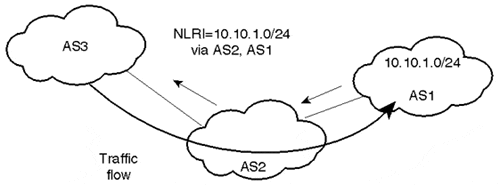
The third part of the UPDATE message is a list of routes that have become unreachable or, in BGP terminology, withdrawn. In Figure 5-11, if 10.10.1.0/24 is no longer reachable, or if it experiences a change in its attribute information, BGP in any of the three ASs can withdraw the route it advertised by sending an UPDATE message that lists the new path attribute information or the network as being unreachable.
Network Layer Reachability Information
One of the primary enhancements of BGP-4 over previous versions is that it provides a new set of mechanisms for supporting classless interdomain routing (CIDR). As discussed in Chapter 3, "IP Addressing and Allocation Techniques," the concept of CIDR is a move from the traditional IP classful (A, B, C) model toward a concept of IP prefixes and a classless model.
The IP prefix is an IP network address that indicates the number of bits (left to right) that constitute the network number. The Network Layer Reachability Information (NLRI) is the mechanism by which BGP supports classless routing. The NLRI is the part of the BGP UPDATE message that lists the set of destinations about which BGP is trying to inform its other BGP neighbors. The NLRI consists of one or more instances of the 2-tuple format <length, prefix>, where length is the number of masking bits that a particular prefix has.
Figure 5-12 illustrates the NLRI <19, 198.24.160.0>. The prefix is 198.24.160.0, and the length is a 19-bit mask (counting from the far left of the prefix).
Figure 5-12. NLRI Example

Withdrawn Routes
Withdrawn routes provide a list of routing updates that are not feasible or that are no longer in service and need to be withdrawn (removed) from the BGP routing tables. The withdrawn routes have the same format as the NLRI: an IP address and the number of bits in the IP address, counting from the left, as illustrated in Figure 5-13.
Figure 5-13. General Form of the Withdrawn Routes Field
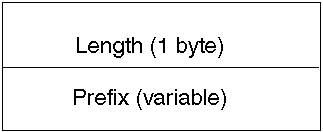
Withdrawn routes are also represented by the 2-tuple <length, prefix> format. A tuple of the form <18, 192.213.128.0> indicates a route to be withdrawn of the form 192.213.128.0 255.255.192.0 or 192.213.128.0/18 in CIDR format.
The Unfeasible Routes Length field in the UPDATE message represents the length in bytes of the total withdrawn routes. An UPDATE message can list multiple routes to be withdrawn at the same time or no routes to be withdrawn. An Unfeasible Routes Length of 0 indicates that no routes are to be withdrawn. On the other hand, an UPDATE message can advertise at most one route, which can be described by multiple path attributes. An UPDATE message that has no new NLRI or Path Attribute information is used to advertise only routes to be withdrawn from service.
Path Attributes
The BGP attributes are a set of parameters used to keep track of route-specific information such as path information, degree of preference of a route, NEXT_HOP value of a route, and aggregation information. These parameters are used in the BGP filtering and route decision process. Every UPDATE message has a variable-length sequence of path attributes. A path attribute is a triple of the form <attribute type, attribute length, attribute value>. The attribute type is a 2-byte field that consists of a 1-byte attribute flag and a 1-byte attribute type code. Figure 5-14 illustrates the general form of the Path Attributes type field.
Figure 5-14. Path Attribute Type Format

Path attributes fall under four categories: well-known mandatory, well-known discretionary, optional transitive, and optional nontransitive. These four categories are described by the first two bits of the Attribute Flags field:
-
The first bit (bit 0) of the Attribute Flags field indicates whether the attribute is well-known (0) or optional (1).
-
The second bit (bit 1) indicates whether the optional attribute is nontransitive (0) or transitive (1). Well-known attributes are always transitive, so the second bit is always set to 1.
-
The third bit (bit 2) indicates whether the information in the optional transitive attribute is complete (0) or partial (1).
-
The fourth bit (bit 3) defines whether the attribute length is 1 byte (0) or 2 bytes (1).
-
The low-order four bits (4 to 7) in the Attribute Flags field are currently unused and are always set to 0.
The following descriptions elaborate on the significance of each attribute category:
-
Well-known mandatory— An attribute that has to exist in the BGP UPDATE packet. It must be recognized by all BGP implementations. If a well-known attribute is missing, a NOTIFICATION error is generated, and the session is closed. This is to make sure that all BGP implementations agree on a standard set of attributes. An example of a well-known mandatory attribute is the AS_PATH attribute.
-
Well-known discretionary— An attribute that is recognized by all BGP implementations but that might or might not be sent in the BGP UPDATE message. An example of a well-known discretionary attribute is LOCAL_PREF.
In addition to the well-known attributes, a path can contain one or more optional attributes. Optional attributes are not required to be supported by all BGP implementations. Optional attributes can be transitive or nontransitive:
-
Optional transitive— If an optional attribute is not recognized by the BGP implementation, that implementation looks for a transitive flag to see whether it is set for that particular attribute. If the flag is set, which indicates that the attribute is transitive, the BGP implementation should accept the attribute and pass it along to other BGP speakers.
-
Optional nontransitive— When an optional attribute is not recognized and the transitive flag is not set, which means that the attribute is nontransitive, the attribute should be quietly ignored and not passed along to other BGP peers.
The Attribute Type Code byte contains the attribute code. Currently, the following attributes are defined as documented in Table 5-2.
| Attribute Number | Attribute Name | Category/Type Code | Related RFC/Internet Draft |
|---|---|---|---|
| 1 | ORIGIN | Well-known mandatory, Type code 1 | RFC 1771 |
| 2 | AS_PATH | Well-known mandatory, Type code 2 | RFC 1771 |
| 3 | NEXT_HOP | Well-known mandatory, Type code 3 | RFC 1771 |
| 4 | MULTI_EXIT_DISC | Optional nontransitive, Type code 4 | RFC 1771 |
| 5 | LOCAL_PREF | Well-known discretionary, Type code 5 | RFC 1771 |
| 6 | ATOMIC_AGGREGATE | Well-known discretionary, Type code 6 | RFC 1771 |
| 7 | AGGREGATOR | Optional transitive, Type code 7 | RFC 1771 |
| 8 | COMMUNITY | Optional transitive, Type code 8 | RFC 1997[1] |
| 9 | ORIGINATOR_ID | Optional nontransitive, Type code 9 | RFC 1966[2] |
| 10 | Cluster List | Optional nontransitive, Type code 10 | RFC 1966 |
| 11 | DPA | Destination Point Attribute for BGP | Expired Internet Draft |
| 12 | Advertiser | BGP/IDRP Route Server | RFC 1863[3] |
| 13 | RCID_PATH/CLUSTER_ID | BGP/IDRP Route Server | RFC 1863 |
| 14 | Multiprotocol Reachable NLRI | Optional nontransitive, Type code 14 | RFC 2283[4] |
| 15 | Multiprotocol Unreachable NLRI | Optional nontransitive, Type code 15 | RFC 2283 |
| 16 | Extended Communities | draft-ramachandra-bgp-ext-communities-00.txt, "work in progress" | |
| 256 | Reserved for development |
